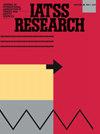A study on spatial exploration of elderly drivers at unsignalized intersections considering road and traffic conditions and driver's physical function
IF 3.3
Q3 TRANSPORTATION
引用次数: 0
Abstract
Unsignalized intersections require more diverse and appropriate physical functions than signalized intersections because traffic is not controlled, and more objects and broader areas must be checked. Elderly drivers may lack adequate physical functions, leading to inadequate spatial exploration and missed recognition, resulting in accidents. This study aims to clarify the spatial exploration behavior of elderly drivers when passing through unsignalized intersections, considering road conditions, traffic conditions, and drivers' physical functions. Participants (n = 62) whose physical function was measured were asked to watch an entry video of 10 intersections using a head-mounted display with eye-tracking function, and the average angular velocity during the viewing was measured. Factorial analysis on spatial exploration showed that the elderly group did not exhibit greater spatial exploration at intersections with acute angles compared to other age groups, even considering physical function effects and traffic conditions through the linear mixed model.
考虑道路交通条件和驾驶员身体功能的无信号交叉口老年驾驶员空间探索研究
由于交通不受控制,无信号交叉口需要比有信号交叉口更多样化、更合适的物理功能,需要检查的对象更多、区域更广。老年司机可能身体机能不足,导致空间探索不足,识别失误,导致事故发生。本研究旨在阐明老年驾驶员在通过无信号交叉口时的空间探索行为,考虑道路状况、交通状况和驾驶员身体机能。参与者(n = 62)被要求使用头戴式显示器观看10个十字路口的入口视频,并测量观看过程中的平均角速度。对空间探索的析因分析表明,即使通过线性混合模型考虑身体功能影响和交通状况,老年人在锐角路口的空间探索能力也没有比其他年龄组更强。
本文章由计算机程序翻译,如有差异,请以英文原文为准。
求助全文
约1分钟内获得全文
求助全文
来源期刊

IATSS Research
TRANSPORTATION-
CiteScore
6.40
自引率
6.20%
发文量
44
审稿时长
42 weeks
期刊介绍:
First published in 1977 as an international journal sponsored by the International Association of Traffic and Safety Sciences, IATSS Research has contributed to the dissemination of interdisciplinary wisdom on ideal mobility, particularly in Asia. IATSS Research is an international refereed journal providing a platform for the exchange of scientific findings on transportation and safety across a wide range of academic fields, with particular emphasis on the links between scientific findings and practice in society and cultural contexts. IATSS Research welcomes submission of original research articles and reviews that satisfy the following conditions: 1.Relevant to transportation and safety, and the multiple impacts of transportation systems on security, human health, and the environment. 2.Contains important policy and practical implications based on scientific evidence in the applicable academic field. In addition to welcoming general submissions, IATSS Research occasionally plans and publishes special feature sections and special issues composed of invited articles addressing specific topics.
 求助内容:
求助内容: 应助结果提醒方式:
应助结果提醒方式:


